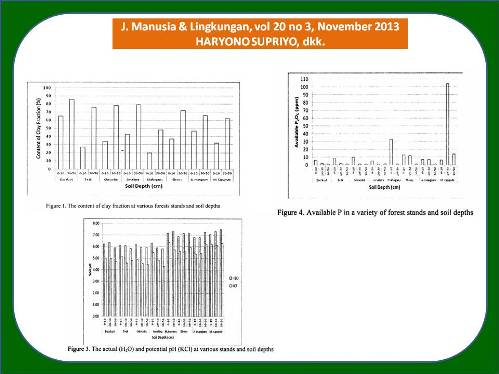
SOIL PROPERTIES OF EIGHT FOREST STANDS RESULTED FROM REHABILITATION OF DEGRADED LAND ON THE TROPICAL AREA FOR ALMOST A HALF CENTURY (Sifat-sifat Tanah Delapan Tegakan Hutan Hasil Rehabilitasi Lahan Terdegradasi pada Daerah Tropika Selama Setengah Abad)
Haryono Supriyo(1*), Daryono Prehaten(2), Arom Figyantika(3)
(1) Laboratory of Tree Physiology and Forest Soil, Department of Silviculture, Faculty of Forestry, Universitas Gadjah Mada, Yogyakarta.
(2) Laboratory of Tree Physiology and Forest Soil, Department of Silviculture, Faculty of Forestry, Universitas Gadjah Mada, Yogyakarta.
(3) Laboratory of Tree Physiology and Forest Soil, Department of Silviculture, Faculty of Forestry, Universitas Gadjah Mada, Yogyakarta.
(*) Corresponding Author
Abstract
ABSTRACT
Physical, chemical and biological properties of soil are influenced by vegetation types which grow above it. Different tree species of stands will produce difference litter quantity, litter quality and also plants’ root system. Therefore quantifying physical and chemical soil properties in several stands after rehabilitation of degraded land will increase the understanding of forest soil characteristics. The research was conducted in 8 forest stands in Wanagama I, Gunungkidul, Yogyakarta. Collection of soil samples was done at the depth of 0-10, 10-30 and 30-50 cm by making soil profile. The result showed that the textural classes were from sandy clay loam to clay. The content of clay increased with increasing soil depth. Bulk density did not differ much among the profiles and soil depth, ranging from 0.90 to 1.28 g/cm3, and so were particle density ranged from 2.19 to 2.55 g/cm3 and pore space ranged from 47.89 to 58.08 %. pH H2O ranging from 5.81 to 7.49 (slightly acid to neutral), meanwhile pH KCl ranging from 4.44 to 6.37. C-organic content varied widely among the vegetations and soil depth ranged between 0.11 and 5.17 %. Available P and total P varied widely from 1 to 104 ppm and from 20 to 390 ppm, respectively. CEC were not much different among the profiles and soil depths, ranging from 19.80 to 38.06 cmol (+)/kg and base saturation in all samples were very high i.e. > 100 %.
ABSTRAK
Sifat-sifat fisik, kimia dan biologi tanah dipengaruhi oleh tipe vegetasi yang tumbuh di atasnya. Perbedaan spesies pohon suatu tegakan akan menghasilkan perbedaan jumlah seresah, kualitas seresah dan juga sistem perakaran. Kuantifikasi sifat-sifat fisik dan kimia tanah pada beberapa tegakan hutan pada lahan terdegradasi setelah direhabilitasi akan meningkatkan pemahaman mengenai sifat-sifat tanah hutan. Penelitian dilakukan pada I jenis tegakan hutan di Hutan Pendidikan Wanagama, Gunungkidul, Yogyakarta. Pengambilan sampel tanah dilakukan pada kedalaman 0-10, 10-30 dan 30-50 cm dengan cara membuat profil tanah. Hasil penelitian menunjukkan bahwa kelas tekstur mulai dari geluh lempung pasiran sampai lempung. Kandungan lempung meningkat dengan semakin dalamnya tanah. Berat volume tidak banyak berbeda antar profil dan kedalaman tanah, berkisar antara 0,90 - 1,28 g/cm3, dan kerapatan partikel berkisar antara 2,19 - 2,55 g/ cm3, dan ruang pori tanah berkisar antara 47,89 - 58,08 %. pH H2O berkisar antara 5,81 - 7,49 (agak asam sampai netral), pH KCI berkisar dari 4,44 - 6,37. Kandungan C-organik sangat bervariasi antar jenis vegetasi dan kedalaman tanah mulai 0,11 - 5,17 %. Kandungan P tersedia dan P total sangat bervariasi, secaraberturut-turut dari 1- 104 ppm dan 20 - 370 ppm. Nilai KPK tidak banyak berbeda antar profil dan kedalaman tanah berkisar antara 19,80 - 38,06 cmol (+)/ kg dan kejenuhan basa untuk semua sampel mempunyai nilai sangat tinggi > 100 %.
Keywords
Full Text:
Artikel lengkap (PDF) (Bahasa Indonesia)Article Metrics
Refbacks
- There are currently no refbacks.
Copyright (c) 2017 Jurnal Manusia dan Lingkungan







